Pennsylvania’s climatic conditions play a crucial role in determining the survival and growth of hummingbird-attracting plants. It’s essential to find plant species that can withstand the state’s warm summers and cold winters. Pennsylvania is divided into different plant hardiness zones, with the majority falling into zones 5 and 6, except for a small area in the southeast categorized as zone 7. This classification helps identify plants that can thrive in specific temperature ranges. Additionally, considering the heat zones is vital to ensure plants can tolerate the hot weather in Pennsylvania.
To create a haven for hummingbirds, it’s recommended to cultivate a diverse selection of flowers suitable for Pennsylvania’s climate. These plants have been carefully chosen based on their compatibility with both cold and heat zones in the state. They not only boast beautiful nectar-rich blossoms that hummingbirds adore but also exhibit resilience in Pennsylvania’s weather conditions.
1. Nasturtiums
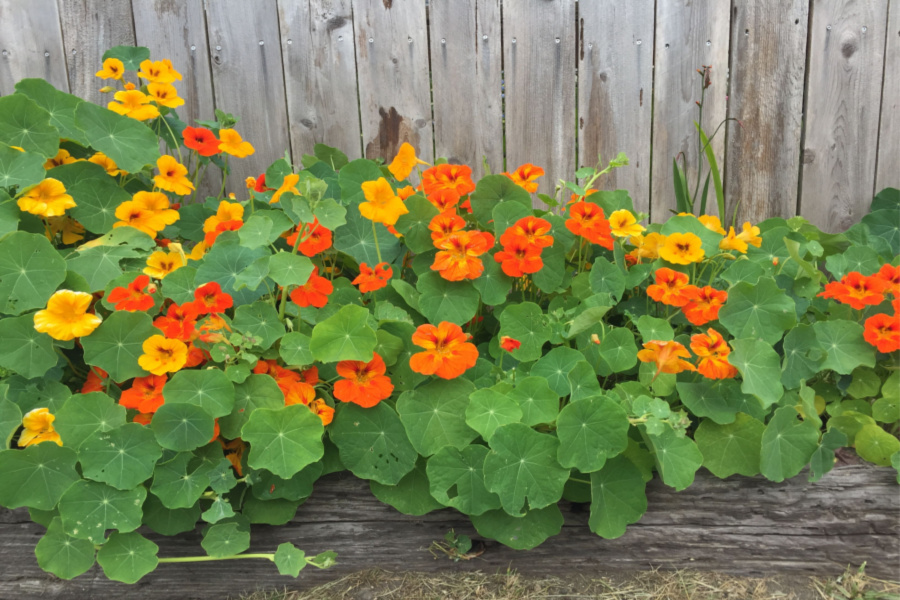
Nasturtiums, trailing flowers with deep, edible blooms, are ideal for hanging baskets and hummingbird attraction. Their vibrant colors and rich nectar appeal to hummingbirds. They can be grown as annuals, with trailing or bush varieties available. Plant the seeds after the last frost, ensuring proper watering and deadheading.
Common Name: Nasturtiums
Scientific Name: Tropaeolum
Growing Zones: 2 – 11
Sun: Full
Soil: Well-drained
Colors: Red, orange, yellow, pink.
Height: 1 – 10 feet
Spread: 1 – 3 feet
Plant Type: Annual
2. Zinnia

Zinnias, flowering shrubs native to North America, belong to the sunflower tribe within the larger Asteraceae family. They come in three main types based on petal structure. Single-flowered zinnias feature a visible center, while double-flowered ones possess numerous rows of petals without a visible center. Semi-double-flowered zinnias have multiple rows with visible centers. Zinnia elegans, a classic favorite, showcases tall stems, vibrant colors, and a long blooming period. It attracts not only hummingbirds but also butterflies. Directly planting zinnias in well-drained soil under full sun ensures their long-lasting and vivid blooms.
Common Name: Zinnia
Scientific Name: Zinnia elegans
Growing Zones: Annuals in 2-8, Perennials in 9-11
Sun: Full sun
Soil: Neutral to slightly alkaline, well-draining
Colors: White, yellow, orange, pink, red, purple
Height: 1 – 4 feet tall
Spread: 12 – 18 feet wide
Plant Type: Annual, Perennial Shrubs
3. Agastache
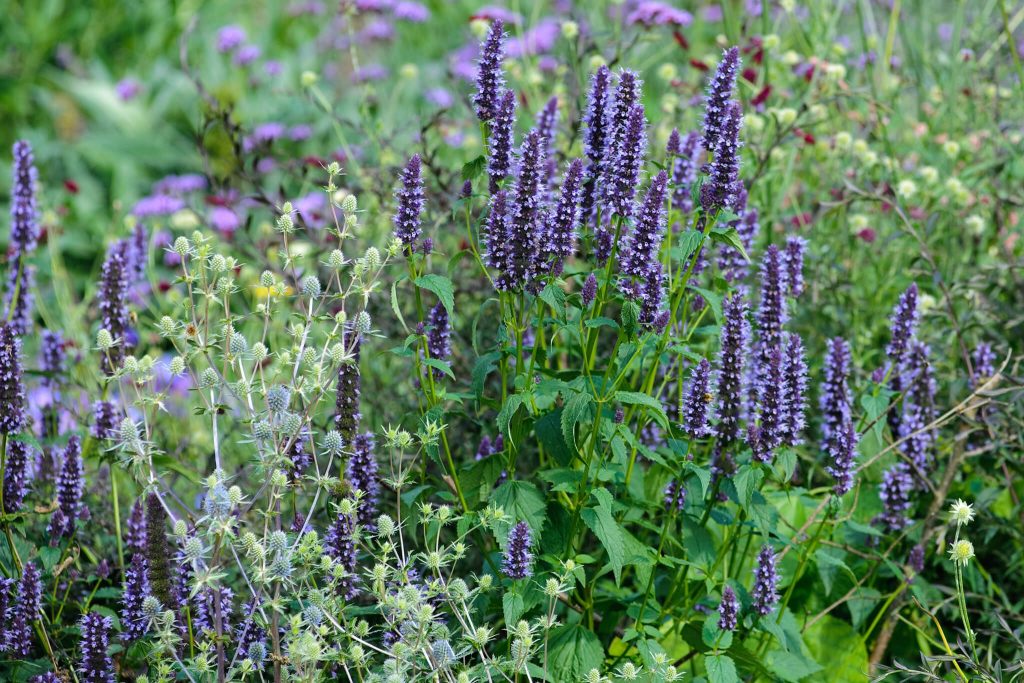
Agastache, also known as “hummingbird mints” and “Giant hyssops,” is an aromatic herbaceous perennial consisting of various species, many native to North America. Its striking purple and red flowers, composed of clusters of tiny blooms, are irresistible to hummingbirds. Starting Agastache plants indoors in May and transplanting them to flower beds during summer ensures optimal growth. Once established, they are drought-tolerant and low-maintenance. However, caution must be exercised to avoid overwatering, as it can harm the roots.
Common Name: Agastache, Hummingbird Mint, and Hyssop
Scientific Name: Agastache
Growing Zones: 3 – 10
Sun: Full sun
Soil: Lean soil, well-drained
Colors: Blue, purple, red, orange, pink, and white
Height: 3 to 5 feet tall
Spread: Varies
Plant Type: Herbaceous perennial
4. Morning Glory
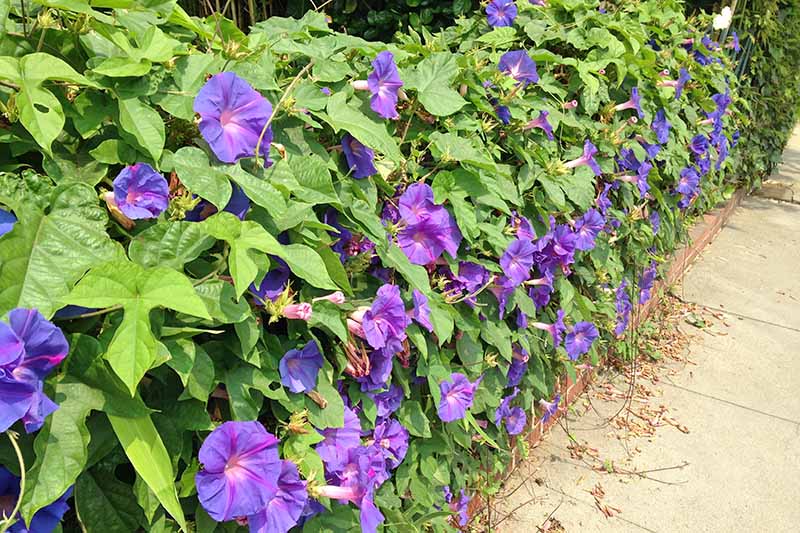
Morning Glory, a member of the Convolvulaceae family, comprises over 1,000 species of flowering plants. These plants derive their name from the fact that their flowers open in the morning and close during the heat of the day. Morning Glory flowers exhibit a wide range of colors, and their fast-growing vines make them ideal for arbors and trellises. Ipomoea purpurea, a popular species attracting hummingbirds, features bright purple trumpet-shaped flowers and heart-shaped leaves. Planting Morning Glory directly in the desired location, ensuring ample sunlight, and avoiding transplantation fosters healthy growth.
Common Name: Morning Glory, common morning glory
Scientific Name: Convolvulaceae family
Growing Zones: 2 – 11
Sun: Full sun
Soil: Moist, well-draining
Colors: White, pink, purple, blue
Height: 6 – 10 feet tall
Spread: 3 – 6 feet wide
Plant Type: Annual
5. Impatiens
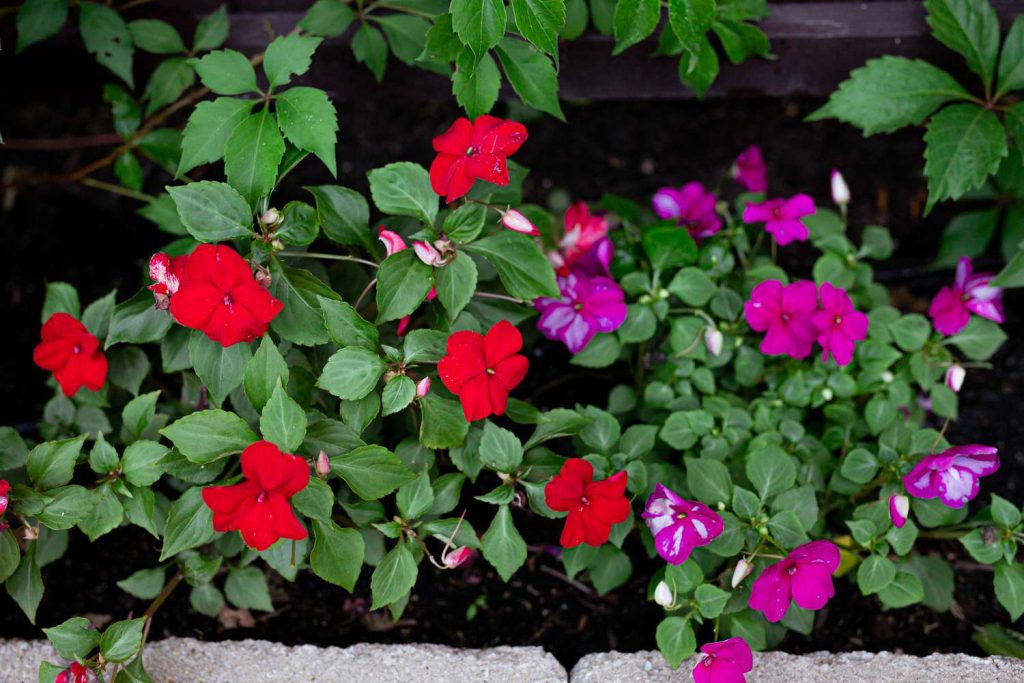
Impatiens, bright and colorful annuals, thrive in shaded areas, making them perfect for enhancing dark corners and attracting hummingbirds. They prefer moist, well-drained soil and deep shade, making them suitable for hanging baskets. Starting impatiens from nursery-bought plants or collecting seeds allows for dense flower and leaf mats. Adequate watering during the growing season and deadheading promotes healthy growth.
Common Name: Impatiens, jewelweed, touch-me-not, snapweed, and patience
Scientific Name: Impatiens
Growing Zones: 2 – 11
Sun: Shade or partial shade
Soil: Rich, well-draining
Colors: Red, pink, purple, yellow, coral
Height: 6 – 36 inches
Spread: 1 – 3 feet
Plant Type: Annual
6. Columbine

Columbine, an elegant perennial plant known as Aquilegia, exhibits a diverse range of vibrant flower colors and thrives in partial shade. Its spiky, bell-shaped blooms measure 3 to 6 inches in length. Columbine is both shade and drought tolerant, making it ideal for Pennsylvania’s climate. Planting columbine seeds directly in the ground during spring allows for self-seeding. Alternatively, starting seeds indoors prior to the last frosts provides a head start. Columbine blooms may not appear until the second year for seed-grown plants.
Common Name: Columbine, Aquilegia
Scientific Name: Aquilegia
Growing Zones: 3-9
Sun: Full sun to partial shade
Soil: Neutral pH, moist but not wet
Colors: Red, pink, blue, orange, white, yellow
Height: 1 – 3 feet
Spread: 1 foot
Plant Type: Perennial
7. Coneflower

Coneflower, scientifically known as Echinacea, encompasses a genus of flowering plants within the Asteraceae family. Their unique central disk gives them the name “coneflower,” and their petals tend to point downward, forming a cone-like shape when the flower head opens. Echinacea purpurea, or the purple coneflower, is a common and attractive variety in backyard gardens, favored by Eastern North America. Coneflowers exhibit large, colorful flowers that attract hummingbirds, bees, and butterflies. These plants thrive in full sun and prefer well-drained soil. Their nectar-rich central cones provide a feast for hummingbirds.
Common Name: Coneflower
Scientific Name: Echinacea
Growing Zones: 3 – 9
Sun: Full sun
Soil: Varies
Colors: White, yellow, orange, pink, red, purple, green
Height: 2 to 5 feet tall
Spread: 1 ½ – 2 feet wide
Plant Type: Perennial
8. Penstemon
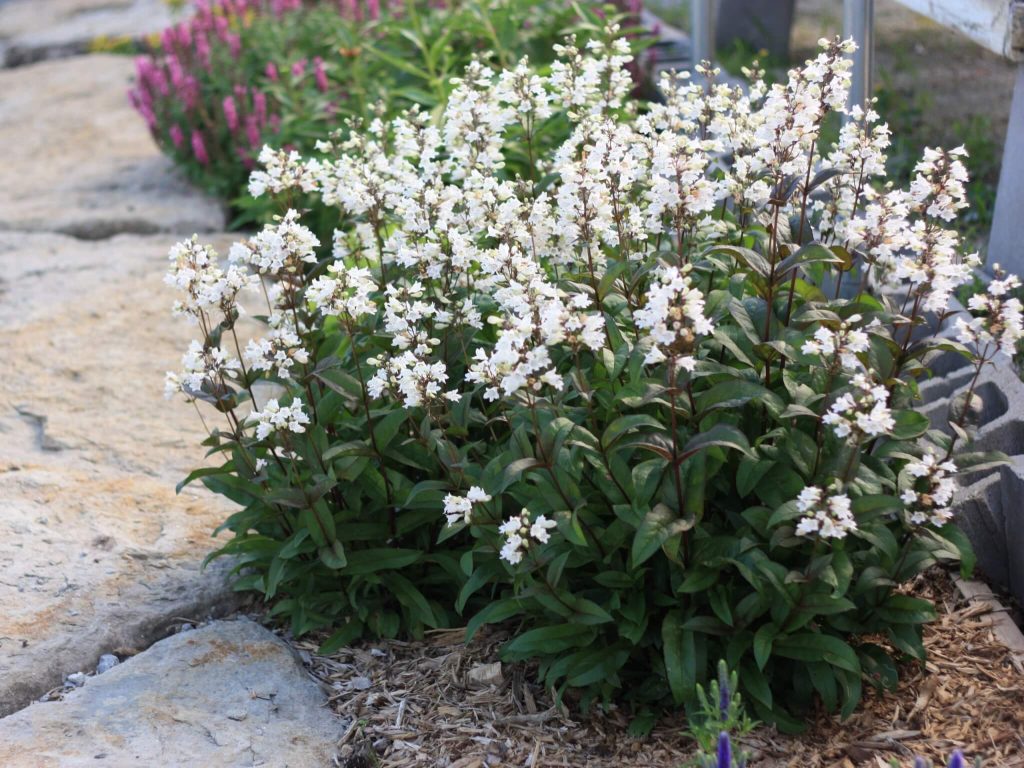
Penstemon, a genus consisting of more than 250 flowering plants, belongs to the Plantaginaceae family. It includes various ornamental species such as snapdragons and foxgloves. Penstemon flowers bloom in early summer, featuring spires and clusters of tubular blossoms. The vibrant colors, including blue, purple, red, orange, white, pink, and yellow, attract hummingbirds due to their brightness and nectar content. These plants thrive in full sunlight, require lean, well-draining soil, and exhibit drought tolerance once established. Choosing a variety suitable for specific soil and climate conditions ensures their longevity.
Common Name: Penstemon, foxglove beard-tongue, foxglove beardtongue, talus slope penstemon, and white beardtongue
Scientific Name: Penstemon
Growing Zones: 3 – 9
Sun: Full sun
Soil: Lean, fast-draining soil
Colors: Blue, purple, red, orange, white, pink, yellow
Height: 6 to 12 inches, 1 to 3 feet, 3 to 8 feet
Spread: 8 to 20 inches
Plant Type: Perennial
9. Summersweet
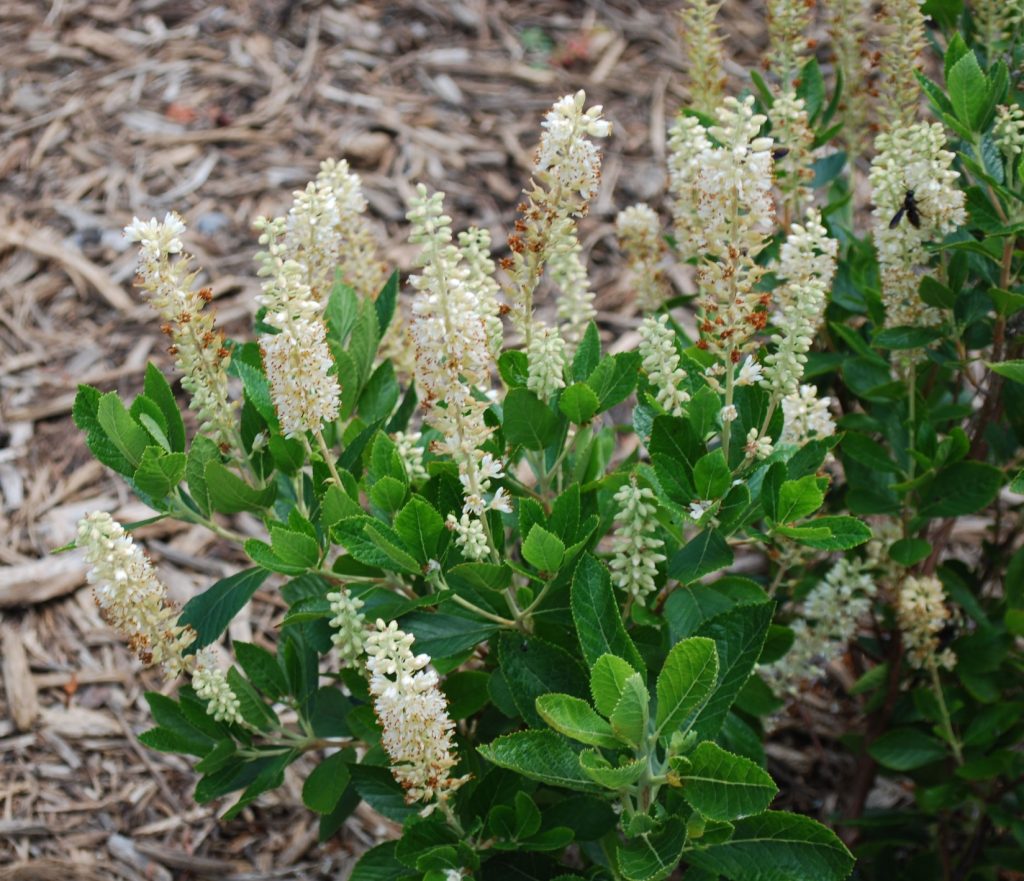
Summersweet, scientifically referred to as Clethra alnifolia, is a flowering shrub known for attracting hummingbirds. It thrives in various climates, particularly wetlands, pond edges, and streams. Summersweet showcases vertical spikes of spicy-smelling white flowers against dark green foliage. Their yellow or golden autumn leaves add further visual interest. Summersweet flowers bloom from July to August, with vibrant colors of white or pink. The fragrance emanating from these flowers allures butterflies and hummingbirds. Summersweet prefers moist to wet soil, thrives in shade, and exhibits tolerance to salty air.
Common Name: Summersweet, coastal sweet pepperbush
Scientific Name: Clethra alnifolia
Growing Zones: 3 – 9
Sun: Full sun or partial shade
Soil: Moist to wet soil, slightly acidic
Colors: White, pink, or rose-colored
Height: 4 – 8 feet tall
Spread: 4 – 6 feet wide
Plant Type: Perennial, Deciduous shrub
10. Yarrow
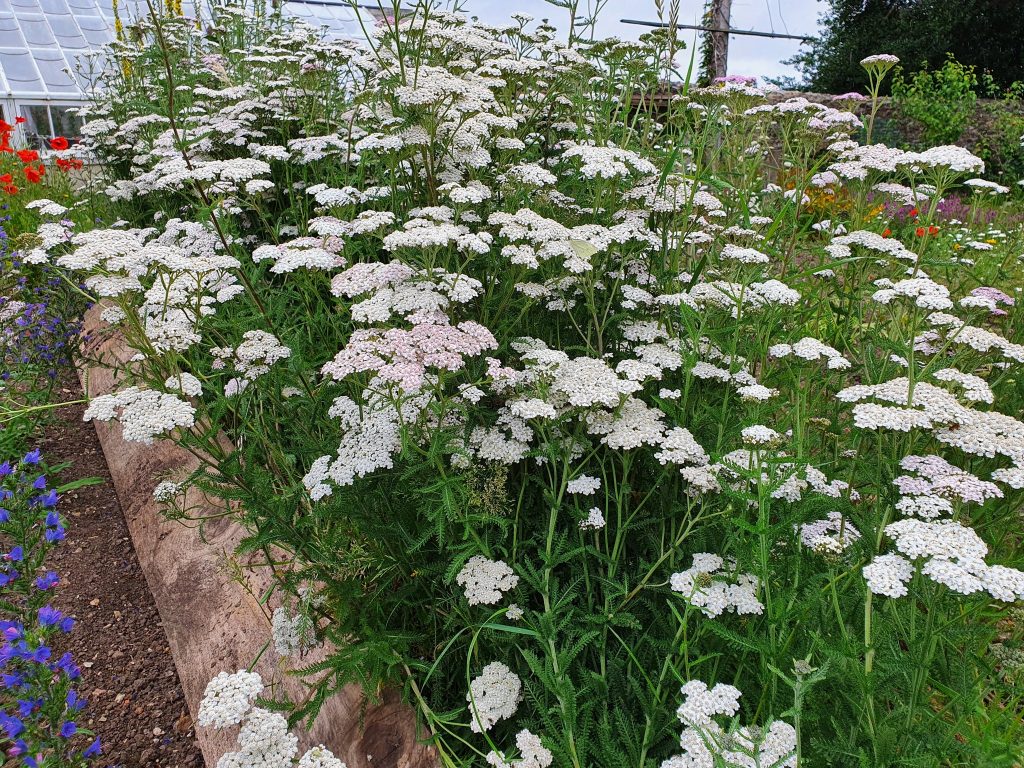
Yarrow, scientifically known as Achillea millefolium, has a rich history associated with its name. It was used by ancient Greek hero Achilles to treat wounds, and its feathery leaves earned it the name “thousand leaves.” Yarrow flowers display clusters of tiny blooms in white, yellow, pink, or red, depending on the variety. These flowers are a favorite of hummingbirds, bees, and butterflies. Yarrow is easy to cultivate in full sun and well-drained soil. Apart from its visual appeal, it has various medicinal uses for ailments such as wounds, burns, colds, fever, and headaches.
Common Name: Yarrow, Common Yarrow, Milfoil, Nosebleed, Thousand-leaf
Scientific Name: Achillea millefolium
Growing Zones: 3 – 9
Sun: Full sun
Soil: Sandy, loamy, clay, well-draining
Colors: White, yellow, pink, red
Height: 2 to 3 feet tall
Spread: 2 to 3 feet wide
Plant Type: Perennial
11. Butterfly Weed
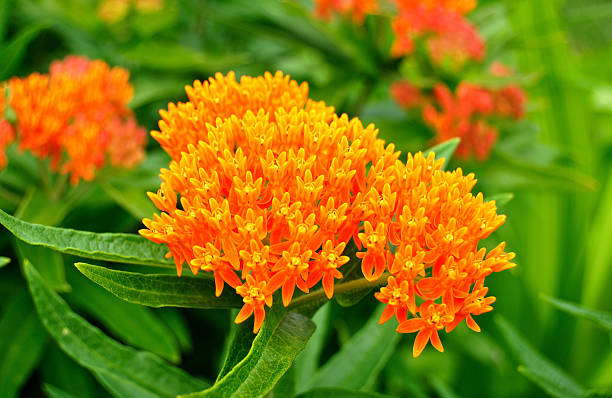
Butterfly Weed, scientifically known as Asclepias tuberosa, is a bushy plant with tuberous roots. It is native to North America and belongs to the milkweed family. As the name suggests, this plant is highly attractive to butterflies, including monarch butterflies. The vibrant orange or yellow flowers of butterfly weed provide nectar and act as host plants for butterfly larvae. This drought-tolerant perennial thrives in full sun and well-drained soil. It is an essential addition to any hummingbird garden, providing a food source for both adult hummingbirds and their offspring.
Common Name: Butterfly Weed, Orange Milkweed, Pleurisy Root
Scientific Name: Asclepias tuberosa
Growing Zones: 4 – 9
Sun: Full sun
Soil: Well-drained, sandy soil
Colors: Orange, yellow
Height: 1 to 2 feet tall
Spread: 1 to 2 feet wide
Plant Type: Perennial
12. Hydrangea

Hydrangeas are stunning flowering shrubs that add a touch of beauty to shady areas of your yard. With their large flower heads, they are a sight to behold. Hydrangeas prefer shade and moist soil, making them perfect for Pennsylvania’s climate. Pruning them in winter after the flowers have faded promotes healthy growth.
Common Name: Hydrangea
Scientific Name: Hydrangea
Growing Zones: 3 – 9
Sun: Full sun to shade
Soil: Fertile, well-draining
Colors: Pink, red, white, blue, green
Height: 3 – 15 feet
Spread: 2 – 12 feet
Plant Type: Perennial
13. Veronica

Veronica is a genus of flowering plants within the Plantaginaceae family, with around 500 different species. These herbaceous perennials come in various forms, including low-growing ground covers and tall plants with vertical flower spikes. Veronica flowers, available in white, pink, purple, and blue, are highly attractive to hummingbirds, butterflies, and bees. They thrive in full sun and well-drained soil.
Common Name: Veronica, Speedwell
Scientific Name: Genus Veronica from the family Plantaginaceae
Growing Zones: 3 – 11
Sun: Full sun, partial shade
Soil: Well-drained
Colors: White, pink, purple, blue
Height: 6 inches to 3 feet tall
Spread: 6 inches to 2 feet wide
Plant Type: Perennial
14. Bleeding Heart
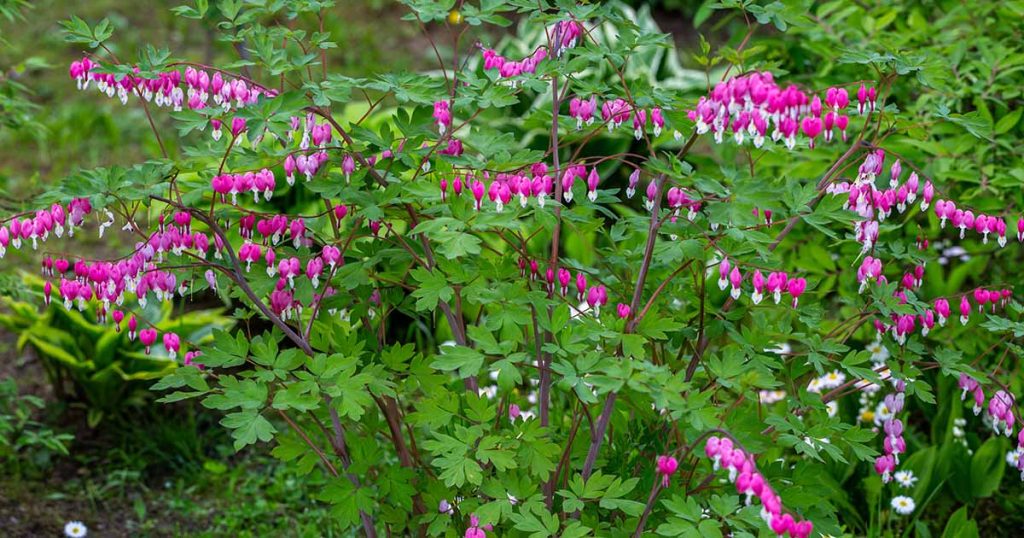
Bleeding Heart, scientifically known as Dicentra spectabilis, is a perennial plant that offers delicate beauty to any garden. Its heart-shaped flowers bloom during spring and release a sweet fragrance. Bleeding Heart plants prefer partial shade but can tolerate full sun. They require well-drained and moist soil. These low-maintenance plants can be planted in hanging baskets or shady corners of your garden.
Common Name: Bleeding Heart
Scientific Name: Dicentra spectabilis
Growing Zones: 3 – 9
Sun: Partial shade
Soil: Well-drained, moist
Colors: Red, white, pink
Height: 3 feet
Spread: 3 feet
Plant Type: Perennial
15. Cardinal Flower
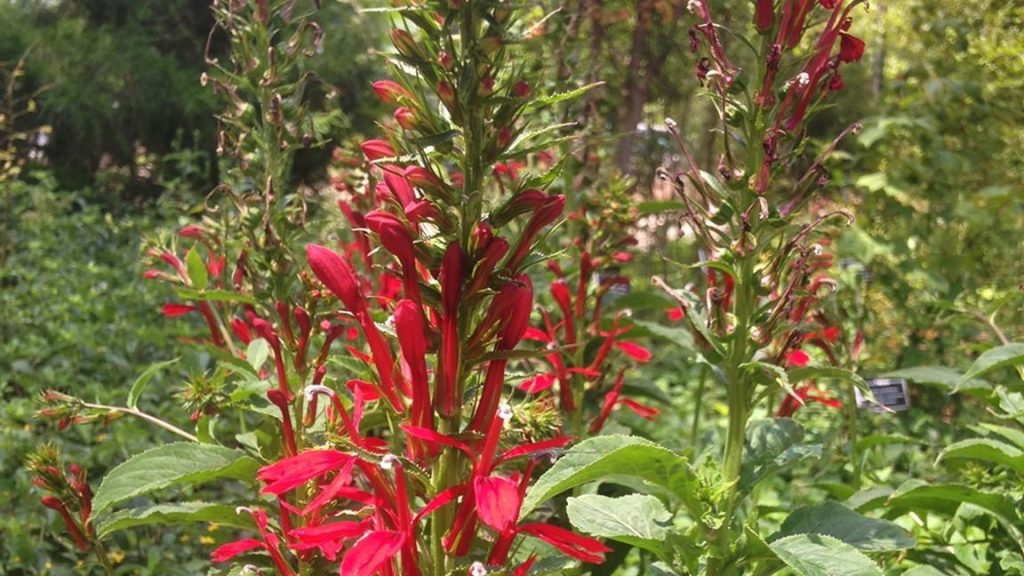
Cardinal Flower, scientifically known as Lobelia cardinalis, is an herbaceous perennial that produces long, bright red tubular flowers. These flowers are specifically designed to attract hummingbirds with their long bills. Cardinal flowers bloom in late summer, and their vibrant red flowers appear on terminal spikes. They prefer rich and moist soil, making sure not to let it dry out. Placing potted cardinal flowers in trays of water can help maintain their required moisture levels.
Common Name: Cardinal Flower
Scientific Name: Lobelia cardinalis
Growing Zones: 3 – 9
Sun: Full sun to partial shade
Soil: Rich, moist
Colors: Red, pink, white
Height: 2 – 4 feet
Spread: 1 – 2 feet
Plant Type: Perennial
16. Bee Balm
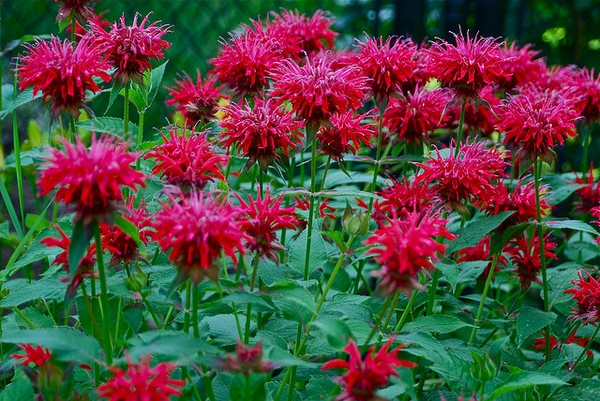
Bee Balm, scientifically known as Monarda, is a vibrant flowering plant that attracts hummingbirds, bees, and butterflies. With its showy flowers available in shades of red, pink, purple, and white, it adds a pop of color to any garden. Bee Balm prefers full sun to partial shade and well-drained soil. Regular watering and deadheading spent blooms can promote continuous flowering.
Common Name: Bee Balm
Scientific Name: Monarda
Growing Zones: 3 – 9
Sun: Full sun to partial shade
Soil: Well-drained
Colors: Red, pink, purple, white
Height: 2 – 4 feet
Spread: 1 – 3 feet
Plant Type: Perennial
17. Trumpet Vine
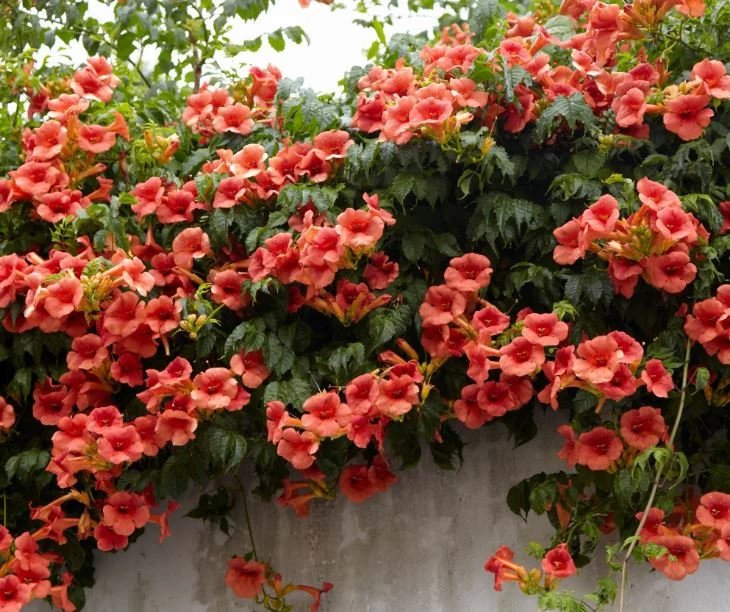
Trumpet Vine, scientifically known as Campsis radicans, is a vigorous climber that produces stunning trumpet-shaped flowers. These vibrant flowers, typically in shades of orange and red, are irresistible to hummingbirds. Trumpet Vines thrive in full sun and well-drained soil. They require sturdy support, such as trellises or arbors, to climb and showcase their beautiful blooms.
Common Name: Trumpet Vine
Scientific Name: Campsis radicans
Growing Zones: 4 – 9
Sun: Full sun
Soil: Well-drained
Colors: Orange, red
Height: 30 – 40 feet
Spread: 5 – 10 feet
Plant Type: Perennial vine
18. Red Hot Poker

Red Hot Poker, scientifically known as Kniphofia, is a striking perennial plant that features tall spikes of tubular flowers. The fiery red, orange, and yellow flowers resemble a poker, hence the name. These vibrant flowers are highly attractive to hummingbirds. Red Hot Poker plants thrive in full sun and well-drained soil. They require minimal watering and can tolerate drought conditions.
Common Name: Red Hot Poker
Scientific Name: Kniphofia
Growing Zones: 5 – 9
Sun: Full sun
Soil: Well-drained
Colors: Red, orange, yellow
Height: 3 – 5 feet
Spread: 1 – 2 feet
Plant Type: Perennial
19. Salvia
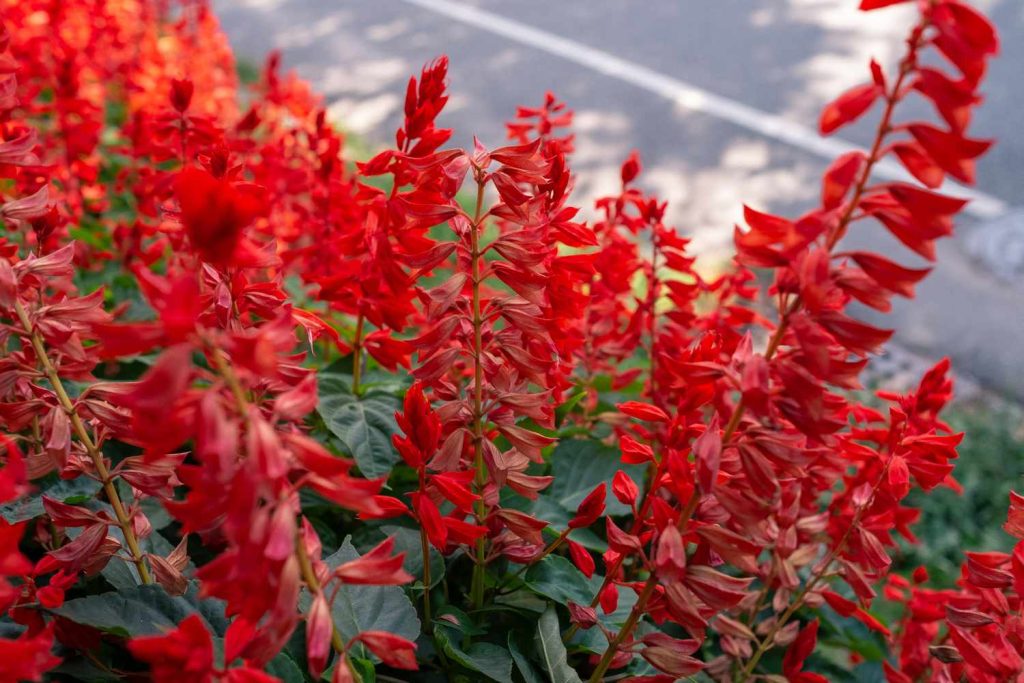
Salvia is a diverse genus of flowering plants that includes numerous species, many of which are adored by hummingbirds. These plants produce beautiful spikes of tubular flowers in various colors, including shades of blue, purple, red, and pink. Salvia plants thrive in full sun and well-drained soil. Regular deadheading can encourage continuous blooming.
Common Name: Salvia
Scientific Name: Salvia
Growing Zones: Varies by species (typically 3 – 9)
Sun: Full sun
Soil: Well-drained
Colors: Varies by species
Height: Varies by species
Spread: Varies by species
Plant Type: Perennial
20. Lantana
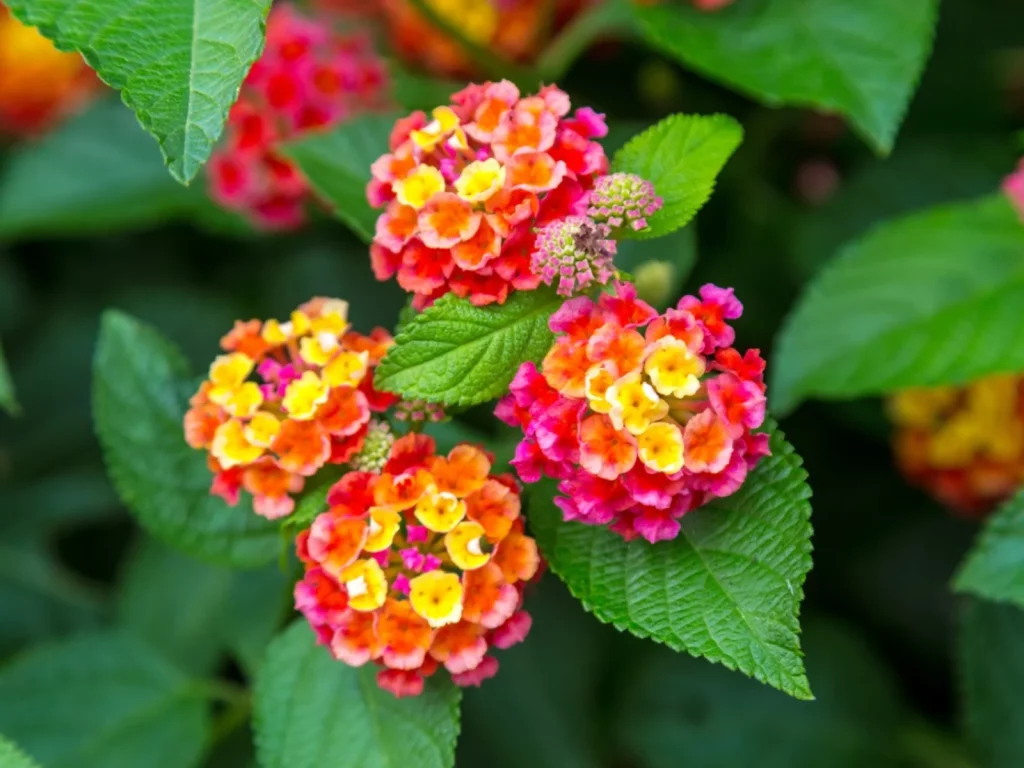
Lantana is a genus of flowering plants that are highly attractive to hummingbirds and butterflies. These colorful plants produce clusters of small, tubular flowers in a variety of hues, including red, orange, yellow, pink, and purple. Lantana thrives in full sun and well-drained soil. They are drought-tolerant once established and require minimal maintenance.
Common Name: Lantana
Scientific Name: Lantana
Growing Zones: Varies by species (typically 8 – 11)
Sun: Full sun
Soil: Well-drained
Colors: Red, orange, yellow, pink, purple
Height: Varies by species
Spread: Varies by species
Plant Type: Perennial
21. Fuchsia
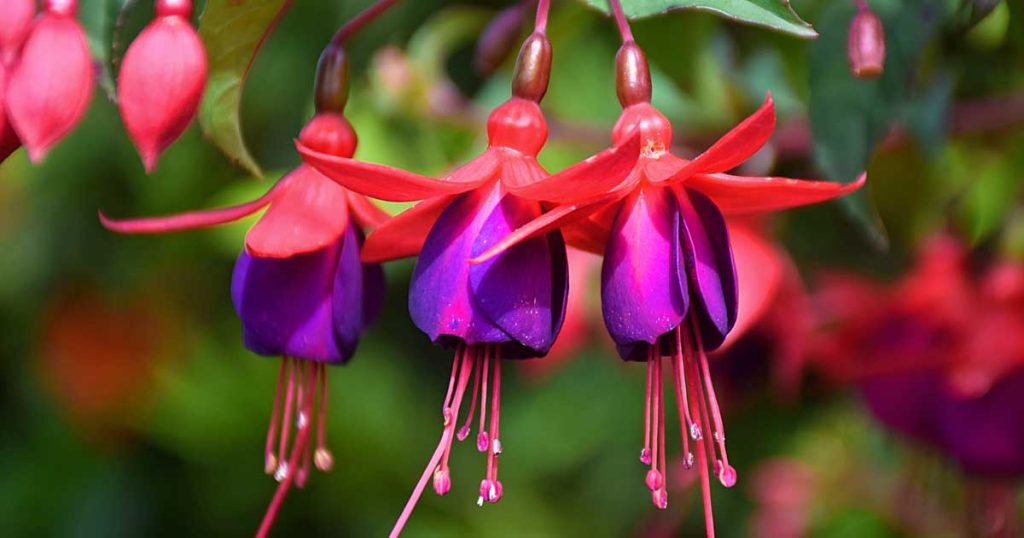
Fuchsia is a genus of flowering plants that produce elegant, bell-shaped flowers. These vibrant flowers, typically in shades of pink, purple, and red, are highly attractive to hummingbirds. Fuchsia plants thrive in partial shade and well-drained soil. They require regular watering to keep the soil consistently moist.
Common Name: Fuchsia
Scientific Name: Fuchsia
Growing Zones: Varies by species (typically 8 – 10)
Sun: Partial shade
Soil: Well-drained
Colors: Pink, purple, red
Height: Varies by species
Spread: Varies by species
Plant Type: Annual or perennial
22. Coral Bells
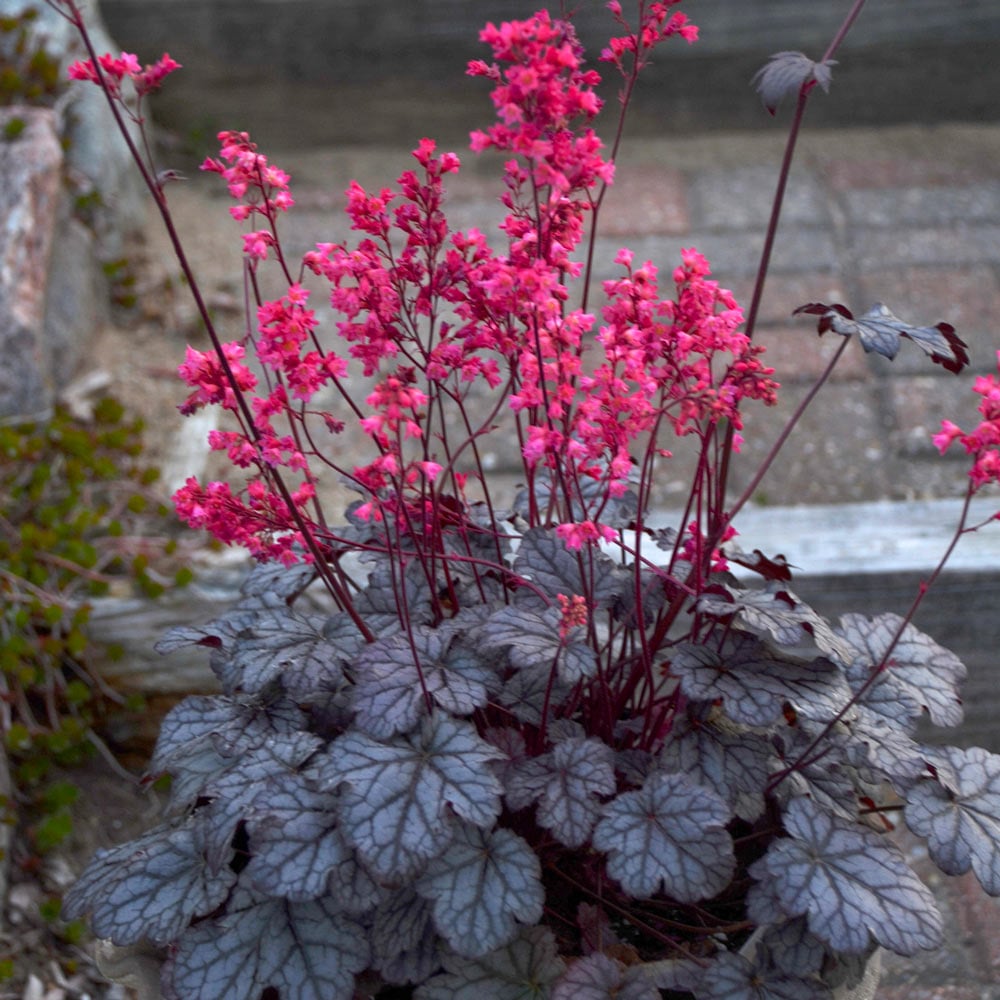
Coral Bells, scientifically known as Heuchera, are perennial plants known for their attractive foliage and delicate flowers. The bell-shaped flowers, available in various colors, including pink, red, and white, bloom on tall stalks. Coral Bells prefer partial shade and well-drained soil. Regular watering and dividing the plant every few years can help maintain its vigor.
Common Name: Coral Bells
Scientific Name: Heuchera
Growing Zones: 4 – 9
Sun: Partial shade
Soil: Well-drained
Colors: Pink, red, white
Height: 1 – 3 feet
Spread: 1 – 2 feet
Plant Type: Perennial
23. Penstemon
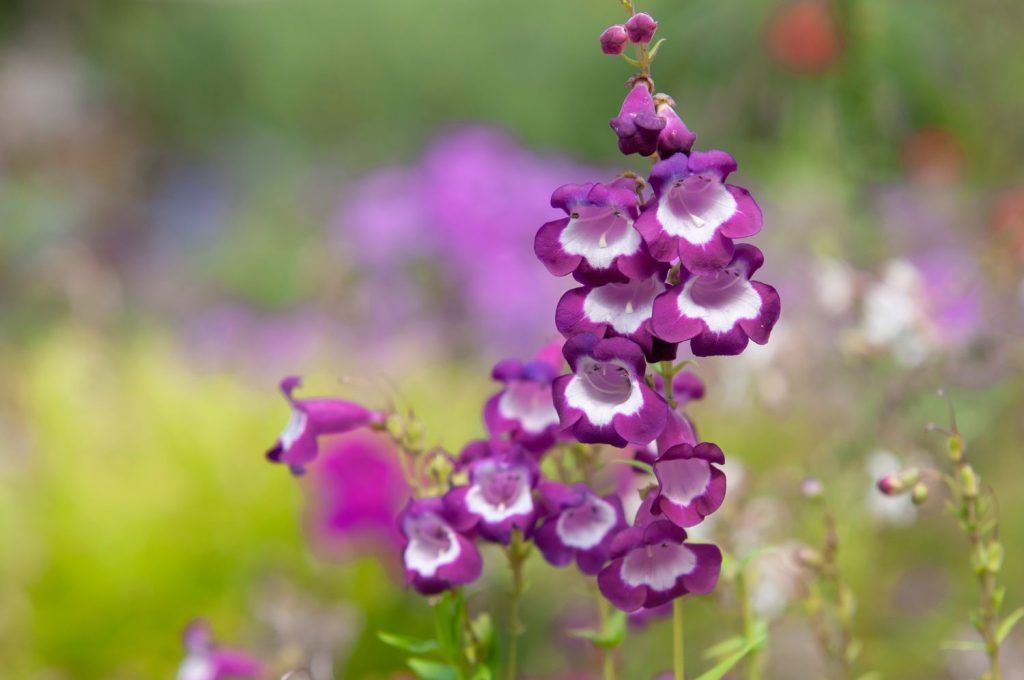
Penstemon is a diverse genus of flowering plants that includes many species loved by hummingbirds. These plants produce tubular flowers in various shades, such as blue, purple, red, orange, white, pink, and yellow. Penstemon plants thrive in full sun and well-drained soil. They are drought-tolerant and require minimal watering once established.
Common Name: Penstemon
Scientific Name: Penstemon
Growing Zones: Varies by species (typically 3 – 9)
Sun: Full sun
Soil: Well-drained
Colors: Varies by species
Height: Varies by species
Spread: Varies by species
Plant Type: Perennial
24. Foxglove
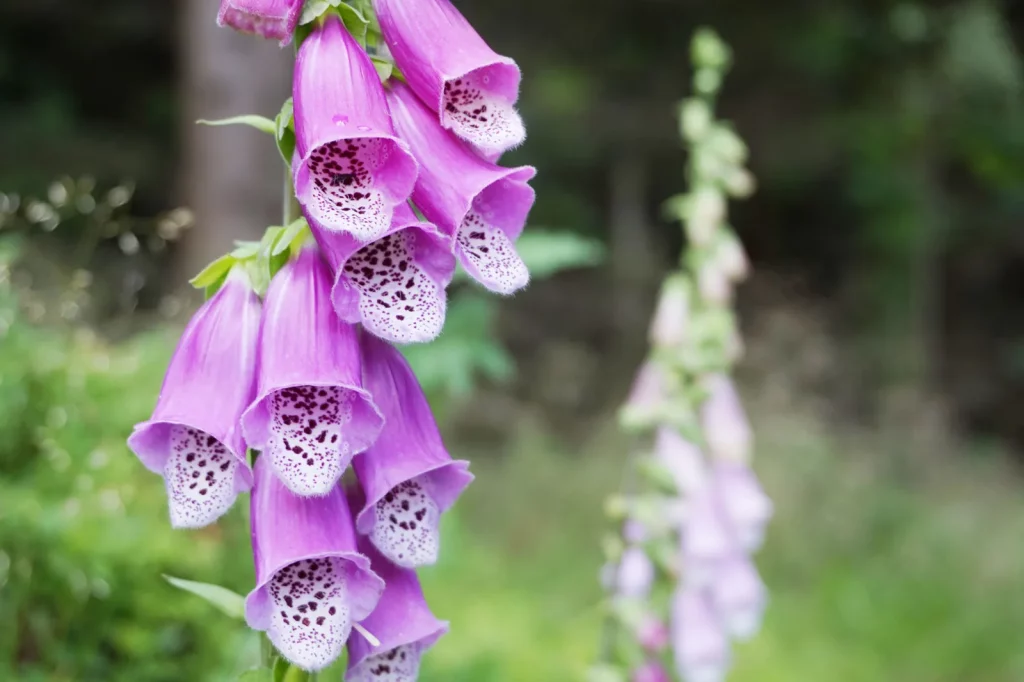
Foxglove, scientifically known as Digitalis, is a tall, biennial or perennial plant that adds vertical interest to gardens. These plants produce tall spikes of tubular flowers in shades of pink, purple, white, and yellow. Foxgloves prefer partial shade and moist, well-drained soil. They self-seed and can naturalize in the right conditions.
Common Name: Foxglove
Scientific Name: Digitalis
Growing Zones: Varies by species (typically 4 – 8)
Sun: Partial shade
Soil: Moist, well-drained
Colors: Pink, purple, white, yellow
Height: 2 – 6 feet
Spread: 1 – 2 feet
Plant Type: Biennial or perennial
25. Cuphea

Cuphea is a genus of flowering plants that are highly attractive to hummingbirds. These plants produce tubular flowers in vibrant colors, including shades of red, purple, orange, and pink. Cuphea plants thrive in full sun to partial shade and well-drained soil. They are drought-tolerant and require minimal maintenance.
Common Name: Cuphea
Scientific Name: Cuphea
Growing Zones: Varies by species (typically 8 – 11)
Sun: Full sun to partial shade
Soil: Well-drained
Colors: Varies by species
Height: Varies by species
Spread: Varies by species
Plant Type: Annual or perennial
26. Bleeding Heart Vine
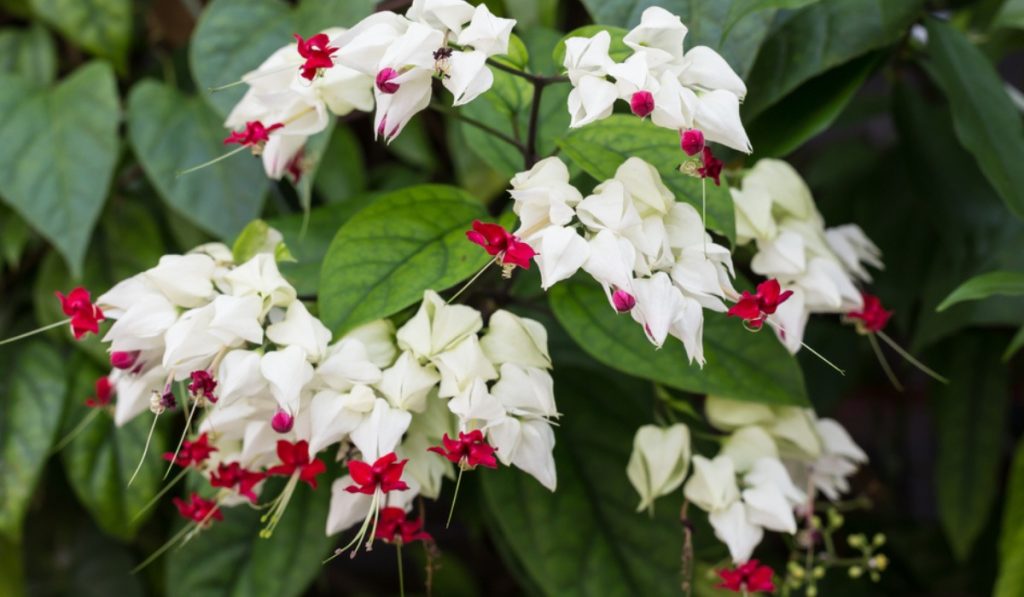
Bleeding Heart Vine, scientifically known as Clerodendrum thomsoniae, is a stunning flowering vine that produces unique, heart-shaped flowers. These flowers feature a white inner petal and a red or pink outer petal, creating a striking contrast. Bleeding Heart Vine thrives in partial shade and well-drained soil. It requires support, such as trellises or arbors, to climb and showcase its blooms.
Common Name: Bleeding Heart Vine
Scientific Name: Clerodendrum thomsoniae
Growing Zones: 9 – 11
Sun: Partial shade
Soil: Well-drained
Colors: White, red, pink
Height: 10 – 15 feet (vine)
Spread: 3 – 6 feet
Plant Type: Perennial vine
27. Lobelia

Lobelia is a genus of flowering plants that includes both annuals and perennials. These plants produce small, tubular flowers in shades of blue, purple, white, and pink. Lobelia plants are highly attractive to hummingbirds. They thrive in full sun to partial shade and moist soil.
Common Name: Lobelia
Scientific Name: Lobelia
Growing Zones: Varies by species (typically 3 – 9)
Sun: Full sun to partial shade
Soil: Moist
Colors: Blue, purple, white, pink
Height: Varies by species
Spread: Varies by species
Plant Type: Annual or perennial
28. Agastache
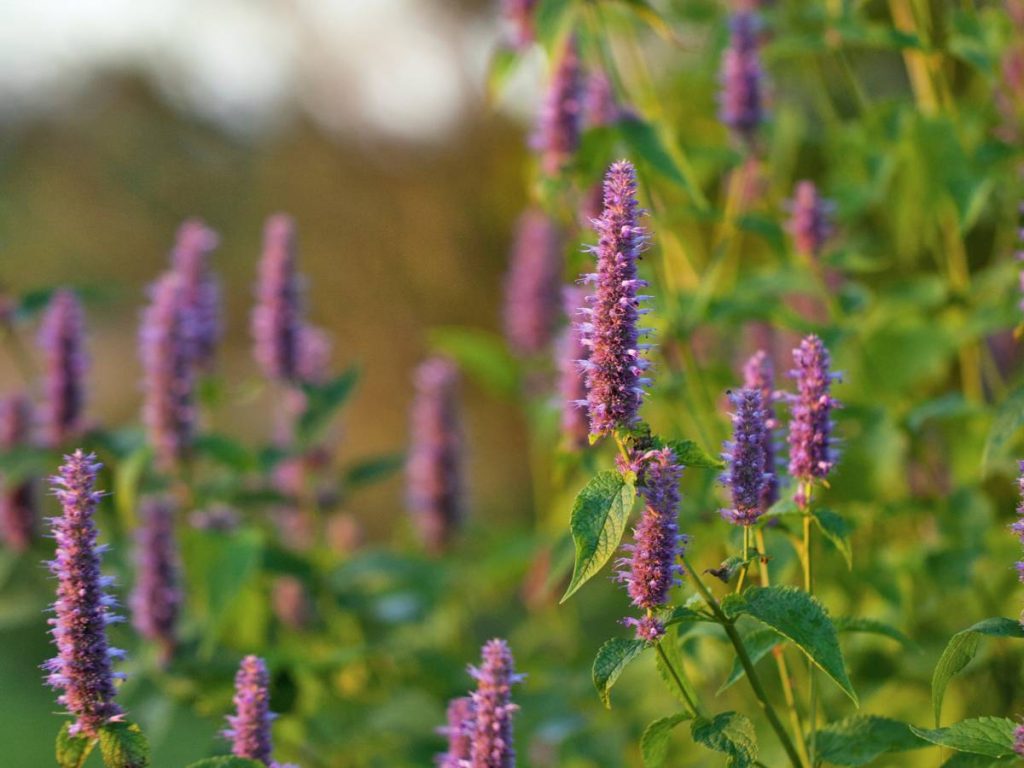
Agastache, commonly known as Hyssop or Hummingbird Mint, is a genus of flowering plants adored by hummingbirds. These plants produce spikes of tubular flowers in shades of blue, purple, pink, and orange. Agastache plants thrive in full sun and well-drained soil. They are drought-tolerant and have a long blooming period.
Common Name: Agastache, Hyssop, Hummingbird Mint
Scientific Name: Agastache
Growing Zones: Varies by species (typically 5 – 10)
Sun: Full sun
Soil: Well-drained
Colors: Blue, purple, pink, orange
Height: Varies by species
Spread: Varies by species
Plant Type: Perennial
29. Petunia
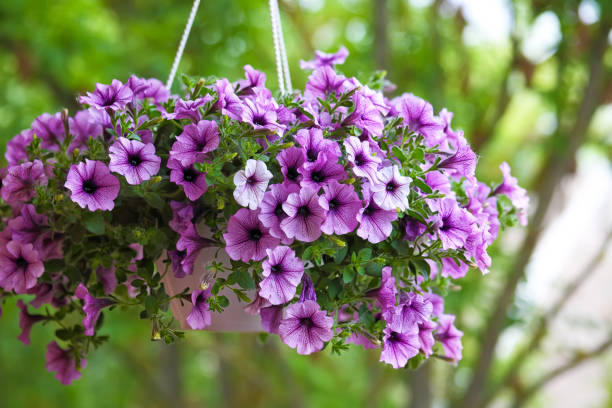
Petunias are popular annual flowering plants available in a wide array of colors and varieties. These plants produce trumpet-shaped flowers that come in shades of pink, purple, red, white, and many more. Petunias are highly attractive to hummingbirds and butterflies. They thrive in full sun and well-drained soil.
Common Name: Petunia
Scientific Name: Petunia
Growing Zones: Varies by species (typically 9 – 11)
Sun: Full sun
Soil: Well-drained
Colors: Varies by species
Height: Varies by species
Spread: Varies by species
Plant Type: Annual
30. Coral Honeysuckle
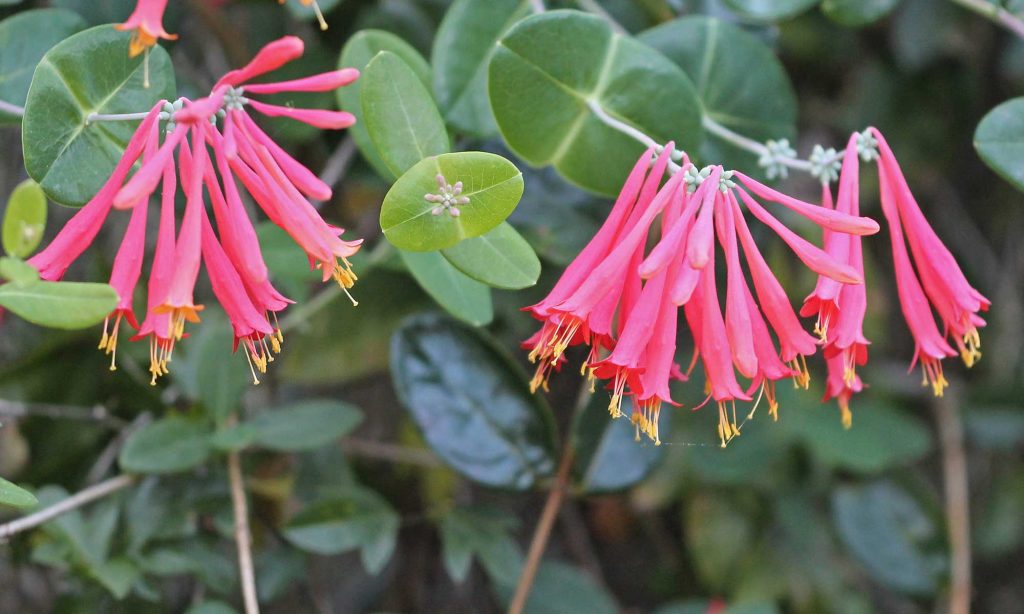
Coral Honeysuckle, scientifically known as Lonicera sempervirens, is a vigorous, twining vine that produces clusters of tubular flowers. The flowers, available in shades of red, orange, and yellow, are highly attractive to hummingbirds. Coral Honeysuckle thrives in full sun to partial shade and well-drained soil. It requires support to climb and showcase its blooms.
Common Name: Coral Honeysuckle
Scientific Name: Lonicera sempervirens
Growing Zones: 4 – 9
Sun: Full sun to partial shade
Soil: Well-drained
Colors: Red, orange, yellow
Height: 10 – 20 feet (vine)
Spread: 3 – 6 feet
Plant Type: Perennial vine
These are just a few examples of plants that can attract hummingbirds in Pennsylvania. Remember to consider your specific location within the state, including the hardiness zone and microclimate, when selecting plants for your garden. Providing a variety of flowering plants that bloom throughout the seasons will help ensure a continuous food source for hummingbirds and create a beautiful and vibrant garden.